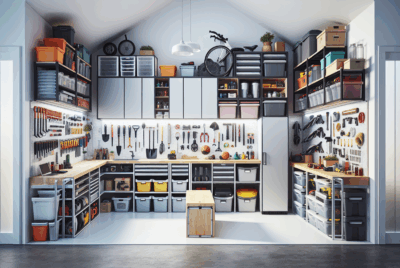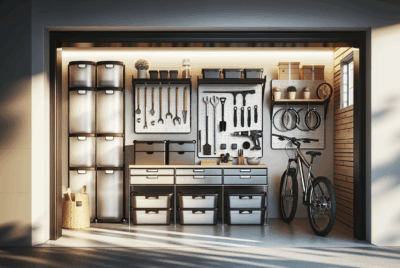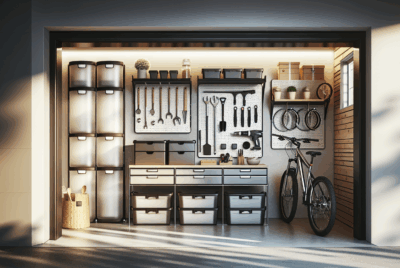Garage Organization Maintenance: Tips for a Clutter-Free Space
As an Amazon Associate, I earn from qualifying purchases, at no additional cost to you. Disclaimer
When I tackle garage organization, I focus on maximizing the space I have.
The key to maintaining a tidy garage is finding efficient storage solutions.
By grouping similar items and using shelves or cabinets, I create designated spots for everything. It makes the space more functional and clutter-free.

To keep my garage in order, I regularly reevaluate my storage solutions.
For example, seasonal items go in clear containers, so I can see what’s inside without digging through boxes. Pegboards are great for small tools, ensuring they’re always easy to find.
I believe in simplicity when it comes to garage organization ideas.
Hooks for bicycles, wall mounts for larger tools, and overhead storage for less-used items work wonders. Organizing this way not only looks neat but also makes maintaining a clean garage easier.
Assessing Your Garage Space

When looking at a garage, I start by considering how space can be better used.
Thinking about how to set up storage is an important part of getting organized. It can make a big difference in both how the garage looks and how easy it is to find things.
Understanding Your Floor Plan
I begin by mapping out the floor plan. I focus on the overall shape of the garage and where doors and windows are.
A simple sketch helps me see how much space I have available. I also note any obstacles or fixed structures like support beams and shelves.
Knowing exactly what space I have helps me plan more effectively.
Using a tape measure, I get accurate dimensions. This information helps me decide the best arrangement for everything in the garage.
I sometimes find it helpful to group similar items together in the plan. That way, it’s easier to think about how I might create different zones within the garage.
Creating a Storage Plan
After understanding my floor space, I need to create zones for storage.
I think about what items I have and use often. Then, I consider how they might be stored to use space better.
Hanging things like bikes on wall hooks helps keep the floor clear.
Shelves and cabinets give me extra places to put tools, boxes, and seasonal items. Storing items vertically maximizes space.
I often find that labeling bins is a big help, so I don’t waste time hunting for things later. Each zone in the garage should have a purpose, whether it is for tools, outdoor gear, or household supplies.
Maximizing Vertical Space

Maximizing vertical space can transform a cluttered garage into a well-organized area.
Overhead racks, pegboards, and shelving units are key tools that increase storage efficiency and make finding items easier.
Installing Overhead Storage Racks
Overhead storage racks are great for freeing up floor space. I find they work best for storing items that aren’t used daily, like seasonal gear or holiday decorations.
These racks attach to the ceiling, keeping boxes and bins out of sight yet within reach when needed.
It’s important to ensure they are installed securely to hold the weight safely. Measure your garage height carefully to make sure your car won’t be obstructed. Also, choose racks with adjustable heights for more flexibility.
This vertical storage solution creates more room for everyday tasks.
Utilizing Wall Space with Pegboards
Pegboards make use of wall space effectively. I use them to hang tools, garden supplies, or any item that can be easily mounted.
What I like is their versatility; you can easily move hooks and shelves around to fit different tools and accessories. This adaptability makes it easier to rearrange as storage needs change.
Use heavy-duty pegboards for larger, heavier items. Don’t forget to label where tools belong to keep the board neat and organized. This approach makes grabbing and returning tools simple, cutting down on clutter.
Incorporating Shelving Units
Shelving units add valuable storage without taking up much space.
I prefer modular shelving, which lets me adjust shelf heights to fit my storage needs. They are excellent for storing large items like paint cans, sports equipment, and gardening supplies.
Place shelves at eye level or above to keep frequently-used items accessible. Wood or metal shelving works best for heavier items. Adding bins or baskets helps keep smaller items contained and organized.
Shelving units are essential for maximizing vertical space in a way that keeps everything in view and easy to reach.
Categorization and Labeling

Keeping a garage organized starts with sorting items and labeling storage spaces. This helps me quickly find what I need and maintain a tidy area.
Sorting and Categorizing Items
I begin with sorting items into groups based on their purpose. Tools go in one pile, gardening supplies in another, and sports equipment in yet another. This makes locating specific items much easier.
Next, I decide which items to keep, donate, or throw away. Anything broken or not used in years gets discarded or repaired.
I create categories like “Tools,” “Outdoor Gear,” and “Seasonal Décor” to make retrieval easy.
Using storage solutions such as bins, shelves, and hooks helps maximize space. I assign each category a specific storage area to prevent clutter.
Implementing Labeling Systems
I label everything to ensure quick identification. For example, every box, bin, and shelf gets a label indicating its contents. I use durable labels to withstand the garage environment.
When labeling, I include details like type, quantity, and condition. This keeps track of items during inventory checks. For instance, a label might read “Power Tools: Drill, 2 Wrenches – Good Condition.”
Creating a consistent labeling system is key. Bold or color-coded labels enhance visibility. This way, everything is easy to find and return to its place once I’m done using it.
Organization Strategies
To keep a garage tidy and functional, I focus on using smart storage solutions and creating specific zones. This helps find items easily and keeps clutter away.
Clear Storage Solutions
I find that clear storage bins are very useful in the garage. They allow me to see what’s inside without opening them.
This saves a lot of time. Transparent bins also help in organizing items by category. I make sure to label each bin with its contents.
Storage cabinets can also be a good addition. They provide hidden storage for tools and supplies that aren’t frequently used.
It’s important to choose cabinets that are durable and adjustable. Shelves in cabinets should be movable to fit larger items.
Creating Specialized Zones
In my garage, I create zones for different activities.
A sports zone holds all the athletic gear and equipment. This includes balls, helmets, and rackets. Items are kept in baskets or on hooks to ensure easy access.
A gardening zone is another useful area, storing tools like shovels and rakes. I use pegboards to hang smaller tools, while larger items are kept in a corner rack.
This way, all gardening supplies stay in one spot, making it easier to start a project without searching for items.
Choosing Modular Solutions
When it comes to versatility, I prefer modular solutions. They allow me to adjust the layout as my storage needs change. Modular shelving units can be added to or rearranged easily.
Storage hubs help in creating a central place for essential items. I can expand the hub with additional units like drawers or cabinets as needed.
This flexibility ensures that space in my garage is used efficiently, adapting to new equipment or changes in activities. By choosing modular options, I keep the garage organized without constant overhauls.
Maintenance Standards
Maintaining a well-organized garage requires commitment to regular tasks. I focus on cleaning routines and decluttering to ensure everything stays in top condition.
Establishing Regular Cleaning Routines
Keeping the garage clean is a key part of regular maintenance.
I set up a simple routine to sweep the floors every week. It’s important to get rid of dirt and dust to keep the space tidy.
Mopping is also necessary. I do this monthly with a mild detergent. It helps fight stains and keep the floor shiny.
Proper ventilation is crucial too. This prevents moisture build-up, helping avoid mold.
Storage surfaces need attention as well. Wiping down shelves ensures everything stays free of dirt and debris.
Conducting Regular Decluttering
Decluttering prevents mess from building up.
I go through all items at least twice a year. This process requires sorting items into three categories: keep, donate, and discard.
I find this approach ensures the garage does not get overcrowded with unused items. Unused tools can take up significant space, so I focus on keeping only what’s necessary.
Rearranging items after decluttering can make a big difference. I make sure everything I keep has a designated place. Labeling bins and boxes helps me find things easily and maintain the new order.
Tool and Equipment Upkeep
Keeping tools and garage mechanisms in good condition improves their lifespan and functionality. Regular attention to tool care and garage door systems can prevent issues and save time.
Managing Tool Maintenance
I start by assessing the condition of each tool.
Checking for rust or wear is crucial. Cleaning tools after each use is important. I use a wire brush or cloth to wipe away dirt or debris.
If a tool has rust, I use sandpaper or rust remover. Sharpen tools like blades and cutters to ensure they work effectively.
Oil moving parts such as hinges and gears to reduce friction. I store tools properly on racks or in boxes to prevent damage.
Regular checks prevent costly replacements. Make a checklist to track maintenance tasks monthly or seasonally. This ensures I don’t miss crucial steps in keeping tools in top shape.
Ensuring Garage Door Functionality
I conduct inspections of the garage door to spot issues early. Listen for unusual sounds when opening or closing.
Lubricate the tracks and rollers monthly to ensure smooth movement. Ensure the springs are intact and have the correct tension.
Look for signs of wear or damage.
Garage doors need to balance properly. I test this by disconnecting the opener and manually moving the door halfway. It should stay in place. Misalignment can strain the opener.
Keep the track area clean and clear of debris. Regular upkeep helps avoid costly repairs and ensures safety while operating the garage door.
DIY Projects and Enhancements
Getting creative in the garage can make a big difference. Custom shelving boosts storage space, while improving usability helps with access and organization.
Custom Shelving and Storage
My garage setup improved a lot with custom shelving. Using sturdy materials like plywood and metal brackets helps hold heavy items.
I measured my garage space first, ensuring the shelves fit perfectly. Building adjustable shelves lets me change space sizes for tools and bins.
Overhead garage storage is handy for seasonal items like holiday decorations or sports gear. Be sure to install them securely, attached to the studs for safety.
Labeling each shelf keeps my space organized and easy to navigate. I place frequently used tools at eye level for quick access.
In small garages, I use vertical spaces by installing shelves along walls. It’s surprising how much room can be made without a big overhaul.
Improving Usability and Accessibility
It’s important to make my garage easy to use. Begin by creating clear pathways through smart layout planning. I arrange tool stations to keep frequently used tools nearby.
For example, hammers and screwdrivers hang on a nearby pegboard.
Installing hooks and tracks on walls keeps the floor clean by storing items like hoses and extension cords neatly off the ground. This helps me find things fast.
I always make sure ladders and larger tools are within easy reach to prevent accidents.
Soft grip handles or motion-sensing lights can also increase comfort and safety, providing great usability for all in high-traffic areas.
Frequently Asked Questions
Maintaining a garage that stays organized involves steps like making checklists, creating zones, and choosing storage solutions. Planning and consistent upkeep are key.
What items should be included in a garage organization maintenance checklist?
I like to start with cleaning supplies, storage bins, hooks, and labels.
Tools for minor repairs and organizers for small items help too. Adding safety equipment and regular inspection dates is beneficial for keeping everything in check.
How can I develop a garage organization plan suitable for my needs?
First, I assess what items I have and how frequently I use them. Grouping similar items together helps.
Setting priorities and allocating space based on usage makes the organization much more functional and manageable.
What are some effective storage solutions for organizing gear in a garage?
I find wall-mounted shelves and pegboards great for getting items off the floor. Overhead storage can be helpful for seasonal or rarely used items.
Clear bins with labels offer easy access and visibility, making it simple to find things.
What are the best practices for maintaining a clean and organized garage?
Regular cleaning schedules work best for me. I make time for checking for pests and ensuring everything is in its place.
Rotating or reassessing items that haven’t been used in a while can keep clutter from building up.
Which zones should be created in a garage to enhance organization?
I divide my garage into zones like tools, sports gear, car care, and gardening. Establishing a specific area for each category means I don’t waste time searching for stuff.
Using floor tape to mark zones can also help maintain order.
Can you recommend tactics for organizing an automotive garage efficiently?
For an automotive garage, I suggest using cabinets or tool chests for storing tools and spare parts.
Wall-mounted racks for tires create more floor space.
Having a dedicated workspace with essential tools within reach makes tasks more efficient.



